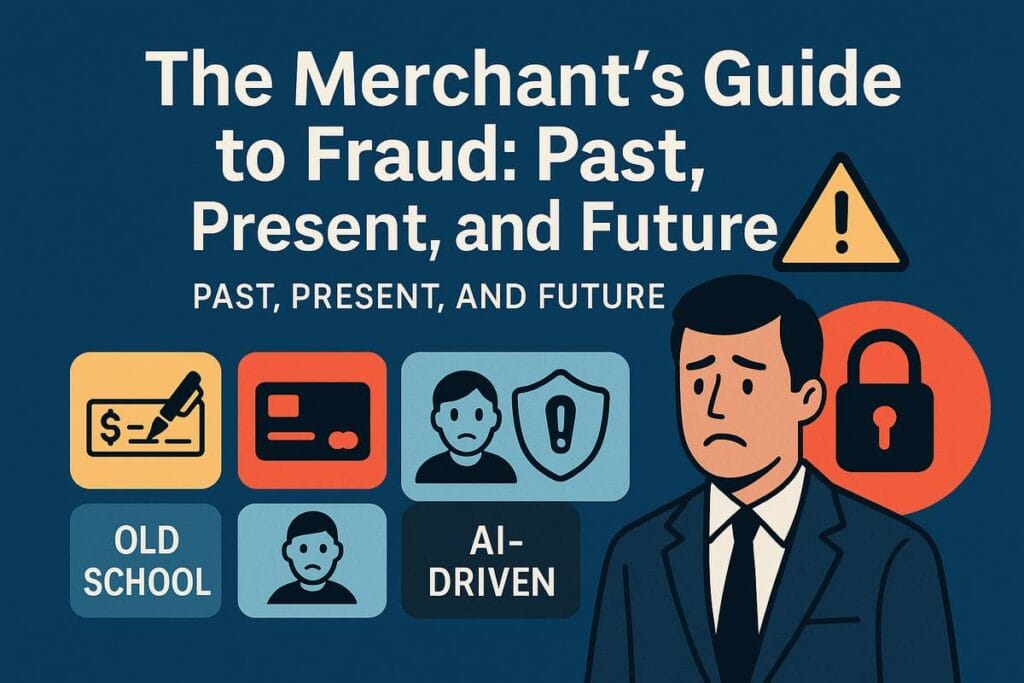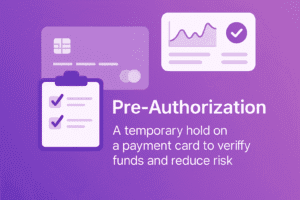The Merchant’s Guide to Fraud: Past, Present, and Future
Fraud has been part of commerce for as long as money has existed. What changes is how it is carried out. From forged checks to AI-generated identities, the threat has only grown more complex. For merchants, understanding the evolution of fraud is key to protecting revenue, reducing chargebacks, and building customer trust.
Old School Fraud
In the 1990s, check fraud alone was costing U.S. banks nearly 10 billion dollars every year. Forged signatures, altered payee details, and counterfeit checks were common. Cash theft and skimming devices placed on payment terminals also became widespread. Identity scams using falsified paper applications were another tactic.
Fraud during this era was manual, but highly disruptive. Merchants had few tools at their disposal beyond bank partnerships and law enforcement, which often meant losses were absorbed rather than prevented.
Current Fraud
The fraud landscape today is dominated by digital schemes. Global card fraud losses are projected to exceed 40 billion dollars by 2027, with card-not-present fraud driving much of that growth as commerce continues to shift online. Fraudsters rely on stolen credentials, automated bots, phishing, and social engineering to exploit gaps in systems. Merchants face the difficult task of keeping security tight while maintaining a smooth customer journey, knowing that too much friction at checkout can cause more damage through false declines than the fraud itself.
A clear example comes from a fraud ring in the United States that impersonated victims in order to access their cellphone accounts. The criminals purchased high-end devices such as iPhones by opening lines under the victim’s name, charging everything to the account holder. Between June 2017 and December 2019, the group stole more than 500,000 dollars in electronics before they were stopped. This case illustrates how organized groups leverage stolen data at scale, leaving businesses with heavy losses.
Friendly Fraud
One of the most damaging forms of fraud today is also one of the least visible. Friendly fraud occurs when legitimate customers dispute valid purchases, often claiming an order never arrived or that the transaction was unauthorized. Nearly 70 percent of chargebacks are thought to fall into this category, costing businesses billions of dollars every year.
A well-known case involved a customer who booked a non-refundable hotel stay using her company email and loyalty account. After a breakup, she filed a chargeback with her bank claiming the charge was not recognized. The merchant lost both the booking revenue and incurred fees, despite the purchase being entirely legitimate. This is often called the “liar-buyer” problem, and it is spreading across industries.
The danger lies in how normalized this behavior has become. Research shows that most buyers see chargebacks as a faster alternative to refunds, and more than half will bypass the merchant entirely and go straight to their bank. Some surveys even show that 40 percent of shoppers admit to filing false disputes, with younger customers being the most likely to do so.
Account Takeover
Account takeover has become another costly threat in recent years. In 2023 alone, U.S. businesses lost 11.4 billion dollars to this type of fraud. Most cases begin with phishing campaigns or credential stuffing attacks where stolen passwords are used to break into customer accounts.
Once inside, fraudsters drain stored payment methods, spend loyalty points, and commit further purchases under a trusted profile. Beyond lost sales, merchants face reputational harm. Customers often hold the business responsible for failing to protect their data, and trust can take years to rebuild.
One highly visible incident occurred in 2024 when a SIM swap attack allowed hackers to hijack the official SEC account on X. They posted a fake announcement claiming that Bitcoin ETFs had been approved, which briefly pushed the price of Bitcoin up by more than 1,000 dollars per coin. This example shows how quickly an account takeover can impact markets, reputations, and trust.
AI-Driven Fraud
Artificial intelligence is reshaping the future of fraud. Generative AI enables criminals to create deepfakes, synthetic identities, and counterfeit documents at a scale that overwhelms traditional defenses. Reports show AI-driven fraud attempts have increased by more than 300 percent since 2022.
Yet AI is also being used to fight back. Real-time behavior analysis now helps identify unusual patterns in customer activity. Adaptive machine learning models evolve alongside fraud techniques. Automated decisioning allows businesses to reduce false positives and save genuine transactions that would otherwise be declined.
The arms race is clear. Fraudsters are using AI to mimic authentic customer behavior while merchants deploy AI to detect the subtlest signs of fraud. Success will depend on who adapts faster.
Crypto Scams
Fraud has followed money into cryptocurrency. In 2021, crypto scams hit a record 14 billion dollars in losses, much of it caused by rug pulls, fake tokens, and laundering schemes. As digital assets continue to grow, fraudsters are exploiting the anonymous and decentralized structure of blockchain transactions.
For merchant accounts, accepting crypto payments can open opportunities, but it comes with risks. Working with trusted partners, maintaining strong compliance, and monitoring transaction flows are critical for staying safe in this new environment.
The Future of Fraud
Looking ahead, fraud will only become more adaptive. Synthetic identities that mix real and fake data are already slipping past KYC checks. Biometric verification systems are being targeted by deepfake technology designed to fool facial, fingerprint, and voice recognition. Decentralized groups are leveraging cryptocurrency and private networks to launch coordinated fraud campaigns.
The most concerning trend is the AI cat-and-mouse game. Fraudsters are using generative tools to impersonate customers, while merchants deploy AI-powered systems to detect the difference. The future will not see fraud disappear. Instead, it will evolve into increasingly complex forms that demand smarter responses. Merchants who adapt quickly, invest in layered security, and educate their customers will be the ones able to stay ahead.
Key Takeaways
Fraud has always existed, but the stakes today are higher than ever. In the past, merchants battled forged checks, counterfeit cash, and paper-based identity scams. Now the challenges are card-not-present fraud, account takeovers, and the rising wave of friendly fraud. The future will be shaped by AI-powered attacks, synthetic identities, and scams within crypto markets.
Merchants must recognize that fraud is not a static problem but an evolving threat. Protecting against it requires layered defenses, advanced detection tools, and a balance between security and customer experience. The businesses that succeed will be those that treat fraud prevention not as a cost, but as a cornerstone of sustainable growth.
What is the difference between friendly fraud and true fraud?
Friendly fraud happens when a legitimate customer disputes a valid transaction, often through a chargeback.
True fraud occurs when a criminal uses stolen information to make purchases. While both cost merchants money, friendly fraud is harder to fight because the buyer is a real customer.
How can merchants protect themselves against account takeover?
Merchants can reduce account takeover risk by requiring strong passwords, using two-factor authentication, monitoring login behavior, and deploying AI-driven fraud detection tools that flag unusual account activity.
Educating customers on phishing and credential safety is also important.
Will AI make fraud prevention easier or harder in the future?
AI is a double-edged sword. Fraudsters are already using it to create synthetic identities and deepfakes.
At the same time, merchants are deploying AI to detect fraud in real time, analyze customer behavior, and reduce false declines. The future will depend on who adapts faster: criminals or businesses.
💡 Interested in learning more about what’s included in a typical high-risk merchant account? View our complete breakdown of FastoPayments’s high-risk merchant accounts.




